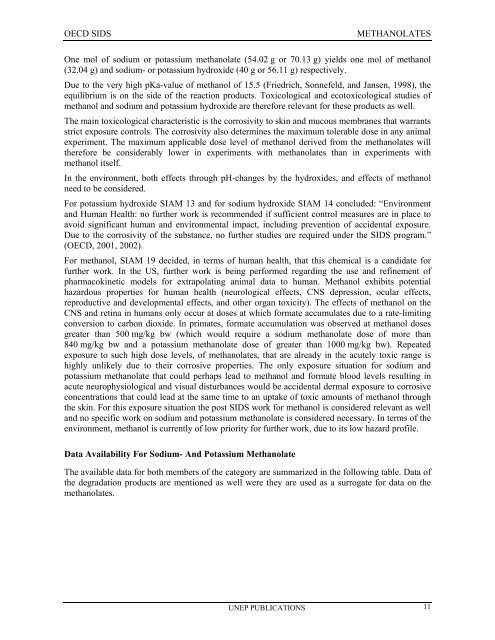Sodium methanolate - ipcs inchem
Sodium methanolate - ipcs inchem
Sodium methanolate - ipcs inchem
Create successful ePaper yourself
Turn your PDF publications into a flip-book with our unique Google optimized e-Paper software.
OECD SIDS<br />
METHANOLATES<br />
One mol of sodium or potassium <strong>methanolate</strong> (54.02 g or 70.13 g) yields one mol of methanol<br />
(32.04 g) and sodium- or potassium hydroxide (40 g or 56.11 g) respectively.<br />
Due to the very high pKa-value of methanol of 15.5 (Friedrich, Sonnefeld, and Jansen, 1998), the<br />
equilibrium is on the side of the reaction products. Toxicological and ecotoxicological studies of<br />
methanol and sodium and potassium hydroxide are therefore relevant for these products as well.<br />
The main toxicological characteristic is the corrosivity to skin and mucous membranes that warrants<br />
strict exposure controls. The corrosivity also determines the maximum tolerable dose in any animal<br />
experiment. The maximum applicable dose level of methanol derived from the <strong>methanolate</strong>s will<br />
therefore be considerably lower in experiments with <strong>methanolate</strong>s than in experiments with<br />
methanol itself.<br />
In the environment, both effects through pH-changes by the hydroxides, and effects of methanol<br />
need to be considered.<br />
For potassium hydroxide SIAM 13 and for sodium hydroxide SIAM 14 concluded: “Environment<br />
and Human Health: no further work is recommended if sufficient control measures are in place to<br />
avoid significant human and environmental impact, including prevention of accidental exposure.<br />
Due to the corrosivity of the substance, no further studies are required under the SIDS program.”<br />
(OECD, 2001, 2002).<br />
For methanol, SIAM 19 decided, in terms of human health, that this chemical is a candidate for<br />
further work. In the US, further work is being performed regarding the use and refinement of<br />
pharmacokinetic models for extrapolating animal data to human. Methanol exhibits potential<br />
hazardous properties for human health (neurological effects, CNS depression, ocular effects,<br />
reproductive and developmental effects, and other organ toxicity). The effects of methanol on the<br />
CNS and retina in humans only occur at doses at which formate accumulates due to a rate-limiting<br />
conversion to carbon dioxide. In primates, formate accumulation was observed at methanol doses<br />
greater than 500 mg/kg bw (which would require a sodium <strong>methanolate</strong> dose of more than<br />
840 mg/kg bw and a potassium <strong>methanolate</strong> dose of greater than 1000 mg/kg bw). Repeated<br />
exposure to such high dose levels, of <strong>methanolate</strong>s, that are already in the acutely toxic range is<br />
highly unlikely due to their corrosive properties. The only exposure situation for sodium and<br />
potassium <strong>methanolate</strong> that could perhaps lead to methanol and formate blood levels resulting in<br />
acute neurophysiological and visual disturbances would be accidental dermal exposure to corrosive<br />
concentrations that could lead at the same time to an uptake of toxic amounts of methanol through<br />
the skin. For this exposure situation the post SIDS work for methanol is considered relevant as well<br />
and no specific work on sodium and potassium <strong>methanolate</strong> is considered necessary. In terms of the<br />
environment, methanol is currently of low priority for further work, due to its low hazard profile.<br />
Data Availability For <strong>Sodium</strong>- And Potassium Methanolate<br />
The available data for both members of the category are summarized in the following table. Data of<br />
the degradation products are mentioned as well were they are used as a surrogate for data on the<br />
<strong>methanolate</strong>s.<br />
UNEP PUBLICATIONS 11
















